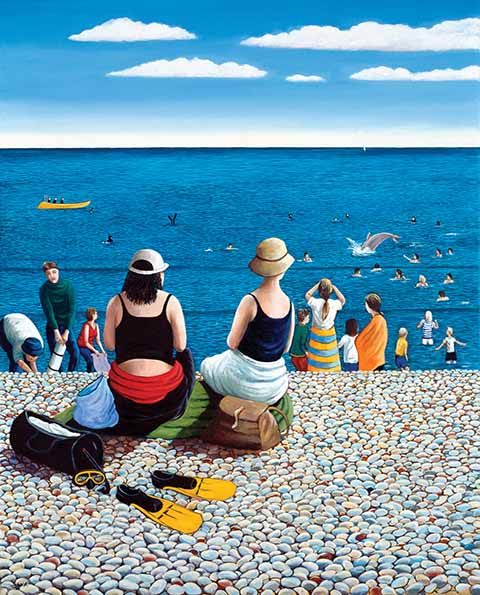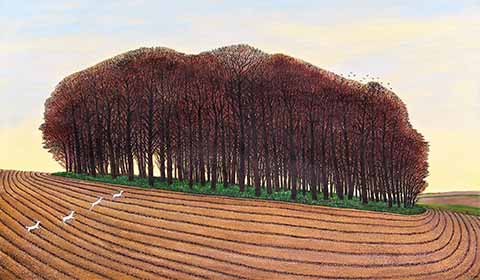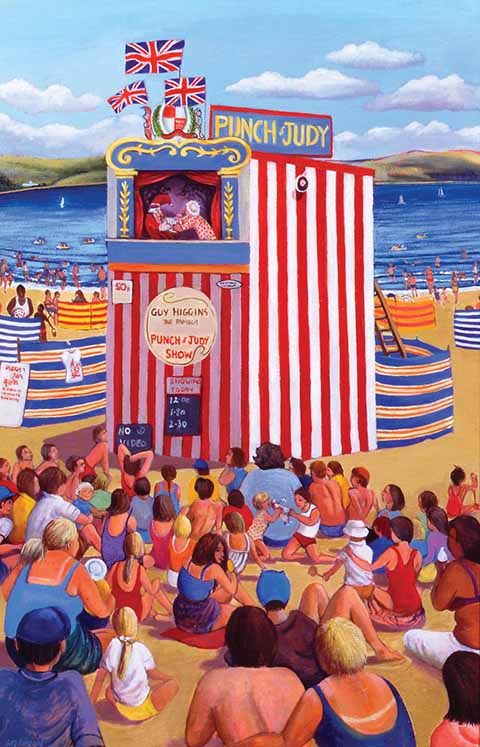Dorset artist – Dolphins and Dorset
Tim Saunders talks to Portland artist Liz Wright, who paints her home island and the wider county with colour and life
Published in August ’19
‘It felt right, a box of light with a brilliant view out the back of the West Wears cliffs.’ That is how Liz Wright describes the house she found when she first visited Portland from her home in Kingston upon Thames, for the opening of the Tout Quarry Sculpture Park in 1983. ‘I had no intention of living on Portland,’ she admits. ‘I rented Ranters Lodge next to Cove House Inn for a week to look at property in Weymouth and the last house I saw was this one, just across the road from Chesil Beach.’
Liz finds herself drawn to the uniqueness of Portland. ‘It’s still a working community and has its own micro-climate and weather, from raging storms to sunny south of France days where the sea is a millpond and the biggest swimming pool ever. Chesil Beach is so fascinating, tons and tons of pebbles always moving, changing shape overnight, constantly. It never rests.’
The quarries, cliffs and coves like Church Ope, with its many huts and changing light, have been a source of inspiration for Liz, who is also attracted to the Bill and St George’s Church. As the Churches Conservation Trust describe it, ‘Vast and solitary, St George’s is one of the most magnificent 18th-century churches in Dorset.’
A magical moment for Liz took place some years ago in August when a common bottlenose dolphin visited the Portland shores. Liz entered the water away from the crowds with her dog, Blake. ‘He got out and I was left on my own,’ she recalls. ‘I looked down and saw a large black shape underneath me. My heart almost stopped with fright. Suddenly I was lifted up gently and the fear vanished. The dolphin dived down and came up and lifted me up again. He popped his head out and I said “Hello”.’ This experience inspired Liz to create her painting, ‘Randy the Dolphin and Divers’.
The storm of 2014 saw her produce ‘Storm over the Cove House Inn’. ‘I had a broken ankle at the time and looking out of my top window, I saw a couple walking down Clements Lane and they suddenly stopped. I had heard the siren going off and hobbled out, only to find the road full of sea water and rubbish from the pub. The landladies remained inside. I have painted them looking out the window. Boats and cars were washed down Big Ope. My car, which had a flat battery, survived but had rusty brakes for years after. I have also produced a painting of the repairing of the beach with diggers. The beach dropped by four to five metres as the pebbles had been sucked out behind a ridge.’
Liz has to go regularly to Powerstock and her journeys take her past a particular clump of trees that inspired another painting. ‘Just before the turning to Little Bredy is this group of trees, which look magnificent in winter. I sketched the trees and took photos for reference. The white deer were added as there are many in that area. When I walked down the old railway track to Powerstock a herd of white deer crossed my path, leaping up one side and down the other.’ Liz sold the painting to a well-known playwright and his wife who saw it in the Times Literary Supplement, illustrating an article.
Sheep at Melbury Park, a kite festival on Eggardon Hill and Punch and Judy at Weymouth seafront have all formed subjects for her paintings. ‘Punch and Judy is an icon, especially of our Weymouth holiday resort. The crowds all gather and participate, shouting out while soaking up the sunshine. ‘I could not resist including life imitating art; a small boy is pinching a little girl’s doll while Punch is grabbing the baby out of Judy’s hands.’
Liz paints most days. ‘I always start with a cup of tea and then go straight out along the sea wall with my young collie, back for breakfast and a bath. Depending if anything needs collecting or hanging, I get that out the way before I press on with the latest painting. I have many on the go at once. Late morning I’ll go for a big dog walk and then back for lunch. A small siesta and then I’ll work until six. Occasionally, I do give myself a day off.’
Liz’s sister, Jennifer, also paints. ‘I followed in her footsteps. I am sure our mother encouraged us both to paint to keep us quiet, but there is a family talent from my father’s mother. We have two nieces who are also artistic, Tracey and Heidi Wright. It is unusual having a sister who is also an artist, but our styles are so different there is no conflict. Jen studied graphics for her degree, where I studied fine art. I always think she’s the natural artist whereas I struggle all the time to work the painting up to my satisfaction. Jen does them really quickly and they flow. We do help each other and have exhibited together in galleries and sometimes at art fairs. We often call each other to discuss framers, galleries and printers and what we have been up to.’
This year has seen Liz’s exhibition at Whitestones Gallery Café, Portland, then she opened her studio in May and June for the Open for Art festival. This month sees her work Art in the Church in August [details tbc]. Liz is also illustrating Lemmy Goes to Heaven, a small book she has written about her first dog dying.





